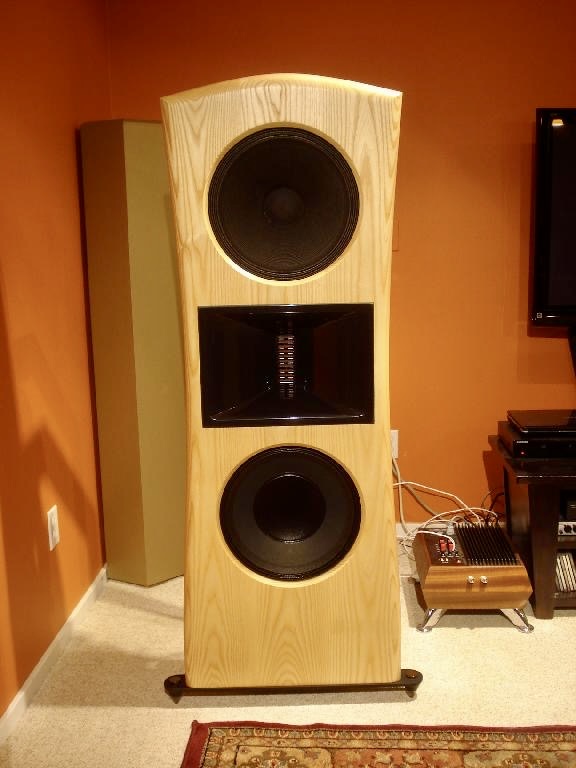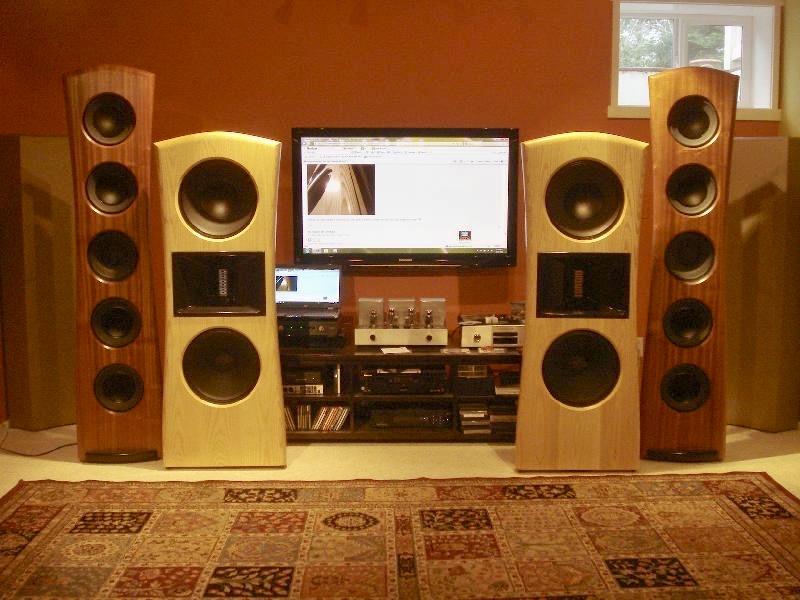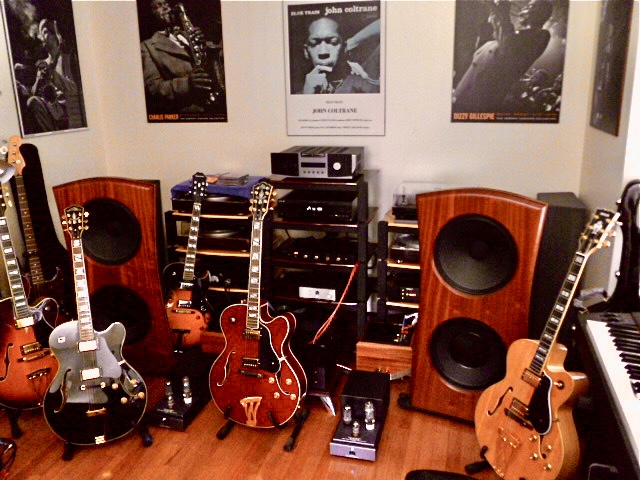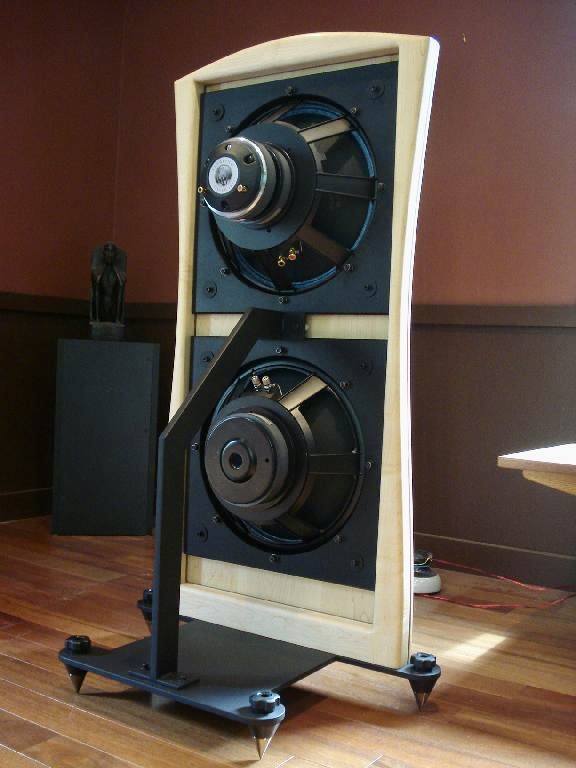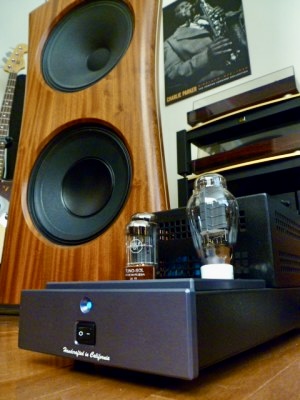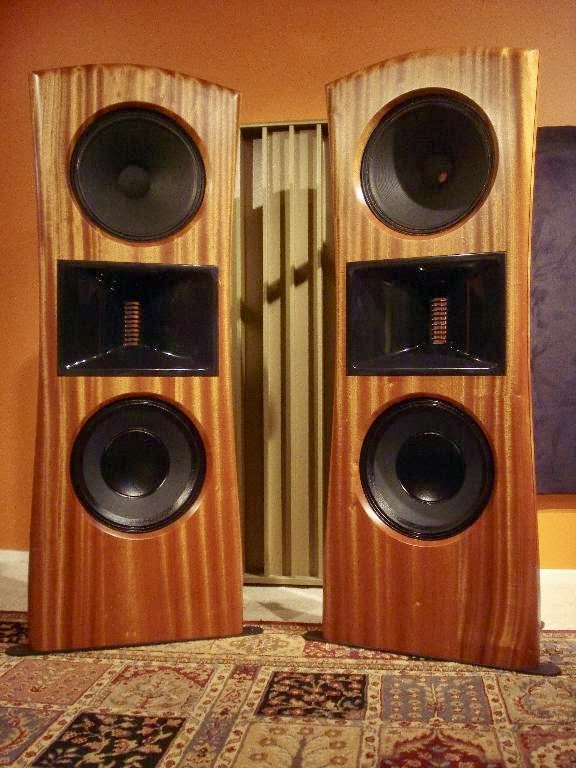@toddalin , sounding great! What speakers are those?
Open baffle speakers
Open baffle speakers design is the simplest , to get bass response similar to other design , like ported, the baffle size must be huge to avoid low frequency degradations . Tipical size the baffle width 10-20" got weak bass performance. I am wondering how open baffle speakers design became so popular ?
@mijostyn You absolutely right , |
@mijostyn, every speaker I’ve posted was an open baffle speaker. The problem is I’ve heard each speaker in small rooms, mid sized rooms, and large rooms. Each speaker performed like no other. The disadvantage you have is, you haven’t heard these speakers. The 15” subs were specifically designed for OB’s. I can’t comment on the design of other OB’s. But I can personally vouch for the performance of these. Each speaker was custom made by hand, by an audiophile who was also an exceptional woodworker. Each speaker was built from solid Sapele, or solid Ash. You don’t find this design on the open market, for most OB’s produced today are finished in Veneers.Therefore, there’s no comparison I understand speaking in generalities. But none of your uncertainty would apply to these OB’s. The quality of them is beyond compare. |
@jaytor @coltrane1 Low bass, below 100 Hz is handily the most difficult part of the audio spectrum to evaluate by ear and even measurement can be tricky. The first tell that there are problems is the baffle shaking or vibrating with low notes. That vibration is distortion. The best way of measuring what is happening is comparing free air response to t in room measured response with short sinewave sweeps measuring at various locations. Regular enclosed subwoofers are bad enough, but Open baffle versions are all over the map. If you think you are getting anything below 30 Hz. Take a pair of subwoofers and put them across the room from one another. Flip one in and out of phase while playing a 25 Hz test tone. Please tell us what happens. |
I had the good fortune to be good friends with Don Barringer who worked with Siegfried Linkwitz on the Linkwitz "Orion" speaker design. Don and I were both professional musicians. Don worked for a number of years as the recording engineer for the U.S. Marine Band in Washington, D.C. Don was constantly experimenting with all things audio and even when Siegfried decided that the Orions had reached peak development, Don continued to tweak and improve them for another 20 years ! A great deal of his concentration went into modifications of the X-Over network and I spent many sessions with him as he brought my X-Over "up to snuff" ! I mention all this to establish his credentials as both a performer and an engineer. One of the most amazing changes to his reference system was when he decided that the Orions needed a rear-facing tweeter. To my recollection, Siegfried agreed with the change and resultant improvement. It was really then that the Orions truly required that they be spaced well away from the back wall. The incredible imaging that these speakers provide should satisfy anyone to whom this facet of performance is important. I've always thought that the bass of the Orions was tuneful and accurate as well as plentiful. The Orions incorporate four 12" woofers facing front and rear. With the advent of amplified musical instruments [of all kinds], bass has become something that it is NOT in the natural world. Most bass instruments do not play very loud and do not produce ripples in your Martini glass ! Tympani, bass drum and organ are exceptions and can be very powerful in their "natural" state. The common belief that a low thud is authentic bass instrument information is incorrect. Of course, the over-amplified electric bass has become ubiquitous but would be useless without the help of a hefty amplifier. Should we call it man-made bass ? In any case, evaluating loudspeakers using recordings of other than natural instruments is very misleading. I enjoy punchy, artificial bass and screaming highs as much as anyone but have never heard the equivalent in the world of natural sound. Open baffle speakers are great if you have a room in which they can do their best. Highly recommended ! |
My experience with OB speakers is that the hype surrounding them in recent years is mostly unwarranted. They do sound different from most box speakers but not necessarily better. Of course if you spend $10K on a well designed OB speaker, it’s likely going to outperform a $5K box speaker. I suspect that many listeners who made the move to Spatial or Pure Audio Project OBs and raved about the performance were upgrading from cheaper box speakers. Personally, despite their considerable shortcomings, I prefer Magnepans and ESLs to any of the dynamic-driver OBs I’ve encountered. One trait that has been consistent among all dynamic-driver OBs I’ve owned or auditioned is substandard imaging, probably due to the requisite width of the baffles. Also, none managed to completely do away with the resonances typically associated with box speakers the same way a panel speaker can.
|
@mijostyn - I have not had that experience. My OB woofers have smoother in-room response than I have ever been able to achieve with conventional box subs. I suspect this is because they don’t excite the side to side room modes as much because of the radiation pattern. My response at the listening position is fairly flat, ultimately rolling off in the upper teens. |
@mijostyn - not with nearfield listening and if that OB works off a competently designed and built field coil driver. You’d have to actually hear one to understand what’s possible. I only need to cross my subs over at 50db - any more affects the nuance of the mid and low woofers. My listening position is 7’ from each woofer, which are 8’ apart 😉
in friendship - kevin |
@ozzy62 Frequency response measurements are taken at 1 meter. The frequency response below 50 Hz of an open baffle woofer in a residential room at a 12 foot listening position is at best unpredictable and more than likely horrendous. An open baffle speaker makes a lot of sense if you were going to cross over to subwoofers at 100 Hz. It is easier to avoid enclosure resonances and you get the advantage of dipole behavior when it comes to room interaction. |
| Post removed |
I like both the OB and the closed model of the Songer speaker. The OB was a two way system using their field coil driver as a woofer/midrange coupled to an OB tweeter. The closed box speaker did not have a tweeter so the field coil driver operated full range. They both sounded very good, which is probably more of a testament to their field coil driver than to other aspects of their design. There is another OB field coil speaker that I've heard made by Treehaus Audio. They use huge slabs of wood cut so that the edges of the panel hold the outer bark of the tree. The speaker can be stunningly beautiful. One of the drivers is an old Klangfilm field coil driver that has been reconditioned. I generally like the sound, though not as much as I do PureAudioProject and Songer Audio speakers, and they do look stunningly beautiful. |
Box speakers with multiple drivers create a slew of problems: cohesive sound across the drivers, degradation in sound quality from cheap connectors and crossovers, uncontrolled sound waves bouncing around inside the cabinet, and a waste of money on cabinet design and manufacture. Get a world-class single full-range driver for the cost of an entry level box speaker. You can even get excelllent quality sound from a $400 set of 15" Lii drivers. Or use an 8" driver with a good sub for the lowest frequencies; it's the right tool for the job. Life is as hard as you make it. |
If money is no object, one of the finest OB's out there is the Songer Audio. It sets a standard I haven't quite heard in any OB speakers. And the build quality is second to none. Get ready to write a serious check, though. https://songeraudio.com/
|
Jamo R909 uses unusually sensitive woofers so they’re louder than the other drivers by default with a rising response, then a filter in the crossover is used to drop the level of the woofers at exactly the rate of their low end rolloff. The result is a passive open baffle speaker that doesnt need active EQ to make up for a drop in low end. |
@phasey Why do Reference 909 not need EQ because of their design? As far as I recall they're plain-jane, drivers-in-a-plank-style open baffle speakers. Although their woofers are quite substantial they should have the same low-end behavior as other, similarly designed open-baffle speakers like Caladans and such. Thanks! |
I own two sets of Open Baffle speakers - Legacy Empires and Jamo R909s. The R909s dont need it because of their design, but open baffles are capable of making a healthy amount of low end if you compensate for the low end drop with an EQ. Both of my OB go down into the 30s and kick drums sound huge on them. I dont know if its specifically the fact they’re open baffle, or simply the diameter of their woofers, but kick drums through literally all of my other speakers I have or have owned sound small in comparison. They’re also both extremely tight and have very even response in the low end and midbass... hilariously I think one of the best types of music for open baffles are dance music and modern pop like Tate McRae, when most people running these speakers are listening to orchestral and jazz. The quality and size of low end and midbass is just so good, and the trend in recent productions are large reverb washes and stereo fx that sound great on an open baffle’s soundstage. Also on both of my OB vocals sound very big. |
Spatial has some quite different views on OB. They have a model which is open baffle/dipole for the woofers, and claims this is superior to conventional woofers because it reduces room interactions and modes, while it encloses the midrange and tweeter drivers so that the sound going backwards does not then reflect and add confusing information on sound location that would adversely affect imaging and muddle the sound. The woofer claim is interesting because it is in keeping with what I have noticed with dipole panel speakers. There is substantial cancellation at the sides that do reduce room interactions one does tend to get less boomy and uneven bass response. I am less convince about not going OB with the midrange and tweeter because I tend to not mind the mid frequencies and highs from the back wave bouncing around the room adding to the reverberant field of sound, provided that the path length is 10 feet or more so the sound is perceived as an echo and will not be confused with the direct sound. |
You are just being obtuse now. You are on some weird mission to denigrate OB speakers for some unknown (not really) reason. I understand how to take measurements with a Radio Shack SPL meter and test tones. And I know all about the correction factors for that meter. I was born at night, but it wasn't last night.
|
I am getting an open baffle speaker in Dec. Do not know the name of it yet, but I heard half of it as a prototype in June (bass was missing). I have a lot of faith in the designer. I will be getting the smallest version which is made for recording studios monitoring consoles. That will also work on an office desktop though I will use stands. My friend told me that his new speaker sounds better than my Yamaha NS5000 speaker that he heard and loved with my CODA #16 amp. I have my doubts about that but if it is in the same ballpark then that would be a home run for my office. His speaker can be driven by 8 watts so I will use the Schitt Aegir 20-watt Class A amp (for now).
|
@ozzy62 Are you measure or just listen ?? |
@mijostyn agree for 100% to produce bass 30 Hz baffle size must be HUGE common OB speakers only can start from 100Hz, you say if anybody dont belived -measure , But no any Loved OB want to measure, Just happy what they get |
There are a couple of opinions referencing the Dahlquist DQ10 "...lack of imaging...". In my experience Speaker imaging in most part is impacted by three components, placement of the speaker(s), speaker design/build and the acoustic dynamics of the listening area. Also to clarify the woofer in the DQ10 is a non-ported sealed unit so that driver is not "open baffle". Jon Dahlquist and his engineering design staff described/introduced the DQ10 as a "5 speaker Phased Array, open baffle" design. The vast majority of industry reviewers and audiophiles then and now still view it in that light. It's ground breaking design remains a highly regarded speaker in the evolution of the audio industry. I'll close by sharing that a brilliant university professor ended a lecture that I attended with the following, "Opinions, by their nature are always correct" She then added as we were about to exit, Oh, do you agree with that observation, what is your opinion of that? Consider that as we shall dialogue on that at our next gathering. She was a pistol that always motivated us to think. |
@jasonbourne71 My very best friend in Miami, a Jewish journalist two decades my elder had DQ 10s. We met at Sound Components, Peter McGrath's high end store. I had just moved down there for med school and I was a fish out of water. Leo and his wife took me under their wing. I already had a pair of Acoustat Xs with their built in high voltage amp which had the most amazing image compared to what I was use to at the expense of bass and volume. Since I lived in the Nurses Dorm (don't ask) I couldn't play them loud anyway. So, I'm over Leo's for the first time sitting in front of his DQ 10s and I mean right in front. Leo listened to speakers like most of us listen to headphones. My response when he asked me what I though was, "Very transparent. I can't tell where anything is but they are very transparent." Thus began my career trying to fix other people's systems. I could never get them to image properly and at that point I had not been exposed to the high school teacher's system that permanently warped my brain, or the HQD system that came next. I did not achieve that level of performance until I got my first pair of Acoustat 2+2s some five years later. The DQ 10s downfall was undoubtedly it's crossover. Within a year Leo had moved over to Acoustat Monitor 4s on top of RH Labs subwoofers controlled by the Dalquist LP1 crossover. Biggest set of headphones you'll ever see. There was no way they were going to perform to their potential in that room, but they did image better than the DQ 10s. |
@invalid I owned Divas for 6 years. I had just moved back to New England in 1987 and picked up my pair directly from the factory in Mass. My previous speakers were Acoustat 2+2s with Tympany 3s before that and several models of Acoustat before that going back to 1978. All dipoles. The Divas chased me right back to Acoustat 2+2s. I use Sound Labs 645-8s now, 8 foot 645s. All dipoles without exception, but only two full range line sources, the 2+2s and the current Sound Labs. The reason you have to dampen the front wall behind dipoles that have thin membranes or ribbons is the sound reflected off the front wall at full volume comes right back at the speaker and is transmitted back through the diaphragms causing severe comb filtering. This creates response irregularities and really messes up imaging. In some cases the effect can be euphonic especially if you have not lived with a system that images properly. It can create a false sense of ambience at the expense of image specificity. At worse it can make things shrill and sibilant. If you go to my virtual system page you can see a device called a SALLIE (Sound Attenuator of Low Level Interference Effects) These are sitting directly behind my speakers and are way more affective than the usual fare. Roger West of Sound Labs only makes them 1 foot wide and I needed them 2 feet wide. Left to my own devices I made them out of Walnut, god forbid someone should look behind the speaker. I had been using plain 4" acoustic foam tiles behind the speakers, but the remaining comb filtering was tying a new digital signal processor up in knots, so I had to do something more drastic. Fortunately it worked. |
@mijostyn : I have a nicely upgraded pair of DQ10's and have no complaints about the 3-D imaging qualities. Go read Harry Pearson's 1975 review in TAS. He praised them for their life-like presentation of space! |
My woofer towers are H-frame open baffle with four servo-controlled 12" drivers. There is obviously cancellation at the lowest frequencies where the backwave wraps around, but the circuitry in the amp does an excellent job compensating for this. The measured response in my 29'x17'x8' room is not without some room interactions, but considerably less so than my previous conventional subs and is the deepest, tightest, and most natural sounding bass I've ever had in my system. To say that open baffle subs can't create excellent bass is hogwash. Yes, you need more power and more radiating area to compensate for the backwave cancellation, but if done properly the bass is superb. Open baffle speakers need some room to sound their best. Most of the manufacturers say 3ft to the wall behind them, but in my experience you really need more than this. I have mine set up approximately 7ft from the front wall and 4ft from the side walls. The side wall distance is less critical since the backwave cancellation helps reduce side wall interactions. As long as I have the space for them, I wouldn't consider switching back to box speakers after living with the speakers I have now. |
@vetsc5 +1 The DQ10 is a remarkable design that 50 (!!!) years later can still compete with today's over-priced speakers. I have a nicely upgraded pair on custom stands. I find the bass adequate though a sub does help if playing pipe organ recordings. |
@mijostyn the wall behind the speakers is not supposed to be damped with the apogee speakers, which are dipole. You are the only person I have ever heard say this. |
The DQ10 was not an open baffle speaker in the purest sense. It was a speaker with numerous time aligned baffles. It was a beautiful sounding speaker that could not image. One has to be specific about what they are calling open baffle speakers. The are bipolar speakers, both sides radiating in phase and dipolar speakers, the sides radiating out of phase. Most open baffle speakers are dipoles and most are planar speakers of one sort or another, ESLs, Ribbons and Planar Magnetics. Trying to do this with multiple dynamic speakers has never worked well. This brings us to line source speakers. Line source speakers project sound more effectively than point source speakers. Acoustic power drops off at the cube of the distance with point sources, but at the square of the distance with line sources which is why you see them at large concerts. Due to their construction, planar speakers fall naturally into the line source category, with some irregularity. For a speaker to project as a line source it has to be longer than the wavelength of the lowest frequency it is to reproduce. For a free standing speaker to project 20 Hz as a line source it would have to be 60 feet long! There is one major caveat. If the line source terminates at a barriers, a walls, floors or ceilings it will maintain line source behavior down to 1 Hz. Dipolar line sources, like any dipole does not like making bass below 100 Hz. This is particularly true of full range dipoles like ESLs. They will do it, but it creates distortion with everything else the speaker is doing. Even if the speaker ends at barriers. typically the floor and the ceiling, it is best to cross over to subwoofers at 100 Hz, but it can not be any old subwoofer. In order to maintain balanced amplitude behavior with distance it has to be a line source subwoofer. Even two subwoofers will get lost under line source speakers. The major problem is most "line source" speakers really are not line sources. A speaker that is 6.5 feet tall in a room with 8 foot ceilings looses it's line source behavior under about 250 Hz. As you move away from these speakers they will become progressively brighter or tinny. Line source, dipole speakers have one huge advantage in residential size rooms. Because they do not radiate sound to the sides, up or down there is way less room interaction. Only the front wall is a problem and this can be easily dampened behind the speaker. Only Horn loaded speakers have dispersion controlled at this level. The OP is right to question the bass performance of "open baffle" speakers. The baffle has to be so large you enter the realm of infinite baffle loudspeakers. People including Linkwitz have tried it, tongue in cheek and they will provide the illusion of bass, but it is far from accurate. What most people are listening to under 100 Hz is a mess anyway. Don't believe me? Measure it for yourself.
DQ10s are not open baffle speakers. They are a bunch of separate, time aligned baffles mounted in a cage with mass insanity for a crossover. They could not image to save their lives. They hold a place in HiFi history next to Bose 901s.
|
I don’t believe that Dalquist DQ10s really qualify as open backs. The woofer is in a separate sealed container (closed back). The lower midrange has a thick piece of padding that covers the back of the cone to remove any rear radiation/reflection. The two dome tweeters are sealed and the piezo is a sealed horn.
|
Hello all, Just wanted to add my personal experience with "open baffle" design speakers. Over 40 years ago I was fortunate to purchase one of the iconic examples of open baffle speakers, the Dahlquist DQ 10s Phased Array as a mirrored imaged pair. I loved their sonic purity and transparency then and I'm happy to say that they are still going strong after 4 decades. They've been driven by various amps over the years and sounded great no matter what was feeding them. Yes, reviews had some knocks over the bass response (factory woofer is a 10" Advent unit) but a subwoofer solved that minor issue. Also the DQ 10s are somewhat power hungry, driven in part by the 5 crossovers in each speaker. I've found a source, Regnar Dahlquist, for Dahlquist parts and upgrade kits. New poly caps, low oxygen p to p wiring, new pots, gold plated binding posts and woofer rebuild. I built my own stands for them as the factory stands were "missing" when I purchased them from Federated Electronics. Salesman cut the price and threw in a pair of Monster Cable 12 gauge speaker cables. Sweet deal at the time.because of that. I now use them exclusively for stereo music driving them with a Prima Luna EVO 400 Integrated tube amp. These were remarkable speakers in their time and are still pure and transparent. Thus closes my contribution to the "open baffle" discussion. My exposure to the open baffle concept is limited but has been rewarding. |
@toddalin How it works is if the rear of the speaker is far enough from the wall (about 5 feet) then there is about a 10millisecond delay of the rear firing information to reach your ear. If a bit less than that, the ear will interpret it as harshness (which is the same reason side wall reflections should be avoided) but at about 10mS, the ear can interpret the information as echo location. The result is a more palpable soundstage. IOW, it is excellent for imaging. BTW most ESLs and planar speakers like Magnaplanars are open baffle so this should come as no surprise. |
"Danny knows some stuff..." "Modest price bracket requirement for his targeted customer"... I have Ayre KX-R Twenty, Ayre QX-5 Twenty, and Ayre MX-R amps. Am I not in the demo? Danny’s speakers offer incredible value because it’s him and one other employee. His overhead is a low as possible. "Smart Money" knows what Danny is doing and they’ve heard it and chuckling about people still buying Revel, Klipsch, etc. etc. etc.
Have you watched the development videos and read development threads of his OB speakers? Have you priced a pair of NX-Otica or NX-Treme with 2 pair of dual OB subs? That is not "easy way out" or "modest in price". I have been there and heard it myself. This is not "budget" stuff. It is a magic mix of hardcore development without the overhead and "accountant speaker designers" having a say in the design, parts, and materials.
|



